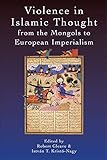Violence in Islamic Thought from the Mongols to European Imperialism / Robert Gleave, István Kristó-Nagy.
Material type: TextSeries: Legitimate and Illegitimate Violence in Islamic Thought : LIVITPublisher: Edinburgh : Edinburgh University Press, [2022]Copyright date: ©2018Description: 1 online resource (256 p.) : 5 B/W illustrationsContent type:
TextSeries: Legitimate and Illegitimate Violence in Islamic Thought : LIVITPublisher: Edinburgh : Edinburgh University Press, [2022]Copyright date: ©2018Description: 1 online resource (256 p.) : 5 B/W illustrationsContent type: - 9781474413015
- 297.27 23
- BP190.5.V56 V558 2018
- BP190.5.V56 V558 2018
- online - DeGruyter
| Item type | Current library | Call number | URL | Status | Notes | Barcode | |
|---|---|---|---|---|---|---|---|
 eBook
eBook
|
Biblioteca "Angelicum" Pont. Univ. S.Tommaso d'Aquino Nuvola online | online - DeGruyter (Browse shelf(Opens below)) | Online access | Not for loan (Accesso limitato) | Accesso per gli utenti autorizzati / Access for authorized users | (dgr)9781474413015 |
Frontmatter -- CONTENTS -- DATES AND ABBREVIATIONS -- FIGURES -- 1. INTRODUCTION -- Part I THE MONGOLS AND THEIR AFTERMATH -- 2. VIOLENCE AND NON-VIOLENCE IN THE MONGOL CONQUEST OF BAGHDAD (1258) -- 3. THE MONGOLS AS THE SCOURGE OF GOD IN THE ISLAMIC WORLD -- 4. YĀSĀ AND SHARĪ‘A. ISLAMIC ATTITUDES TOWARDS THE MONGOL LAW IN THE TURCO-MONGOLIAN WORLD (FROM THE GOLDEN HORDE TO TIMUR’S TIME) -- 5. UNACCEPTABLE VIOLENCE AS LEGITIMATION IN MONGOL AND TIMURID IRAN -- PART II VIOLENCE IN RELIGIOUS THOUGHT -- 6. RECONCILING IBN TAYMIYYA’S LEGITIMISATION OF VIOLENCE WITH HIS VISION OF UNIVERSAL SALVATION -- 7. MORAL VIOLENCE IN AḤKĀM AHL AL-DHIMMA BY IBN QAYYIM AL-JAWZIYYA -- 8. AL-KARAKĪ, JIHĀD, THE STATE AND LEGITIMATE VIOLENCE IN IMĀMĪ JURISPRUDENCE -- PART III VIOLENCE IN PHILOSOPHICAL THOUGHT -- 9. LEGITIMATE AND ILLEGITIMATE VIOLENCE IN ARABIC POLITICAL PHILOSOPHY: AL-FĀRĀBĪ, IBN RUSHD AND IBN KHALDŪN -- 10. ‘SOFT’ AND ‘HARD’ POWER IN ISLAMIC POLITICAL ADVICE LITERATURE -- PART IV REPRESENTING VIOLENCE -- 11. OLD IMAGES IN NEW SKINS: FLAYING IN THE IRANIAN VISUAL TRADITION -- 12. WARRANT FOR GENOCIDE? OTTOMAN PROPAGANDA AGAINST THE QIZILBASH -- BIBLIOGRAPHY -- INDEX
restricted access online access with authorization star
http://purl.org/coar/access_right/c_16ec
Examines the development of Muslim theological, legal, literary and cultural discussions about violence and its legitimationThe violent conquest of the eastern part of the lands under Muslim rule by the Mongols marked a new period in the history of Islamic civilisation and in attitudes towards violence. This volume examines the various intellectual and cultural reactions of Muslim thinkers to these events, both within and without the territories subjected to Mongol control. Each chapter examines how violent acts were assessed by Muslim intellectuals, analysing both changes and continuity within Islamic thought over time. Each chapter is structured around a case study in which violent acts are justified or condemned, revealing the variety of attitudes to violence in the medieval period. They are framed by a detailed introduction, focusing on theoretical perspectives on violence and religion and their application, or otherwise, to medieval Islam.Key FeaturesExamines the portrayal of violence in a variety of Muslim intellectual contexts (historical, philosophical, theological, legal, literary, artistic)Employs a broad understanding of violence – from warfare between Muslims (and between Muslims and others) to individual acts of violenceEnables a better-informed debate about the nature of violence in Islamic thought, and how the positions developed in early Islam were both used and abandoned by later writersPositions these classical conceptions of violence and its justification in Islamic thought in the broader methodological debate over violence and its relationship with religious thought
Mode of access: Internet via World Wide Web.
In English.
Description based on online resource; title from PDF title page (publisher's Web site, viewed 29. Jun 2022)


